
Europe and Mediterranean: Epicurean Pageantry
Regent Seven Seas Cruises
The peaceful setting of the picturesque port of Honfleur along the Seine attracted many artists and writers over the years, including English painter Bonington, French painter Boudin, French poet Charles Baudelaire and later the members of Impressionist Painters. Throughout its history, numerous maritime journeys were initiated from Honfleur. It is especially known for its old, beautiful picturesque port, characterized by its houses with slate-covered frontages.

All onboard gratuities
Select complimentary shore excursions**
Unlimited beverages, including fine wines and premium spirits served throughout the ship
In-suite refrigerator replenished daily with soft drinks, beer and bottled water
24-Hour room service
No charge for specialty restaurants
Welcome bottle of Champagne
US $ 100 Shipboard credit per suite††
Executive Member Benefit
Executive Members receive an annual 2% Reward, up to $1,250, on qualified Costco Travel purchases
Executive Members receive an additional $100 shipboard credit per suite (not combinable with certain past-guest discounts)††
Digital Costco Shop Card
Member Exclusive: Digital Costco Shop Card with every Regent Seven Seas Cruises® sailing†
Sailing Itinerary

Note: Cruise itineraries are subject to change. Please verify ports and times directly with the cruise line.
Overview
Amsterdam is the Netherlands’ capital, known for its artistic heritage, elaborate canal system, and narrow houses with gabled facades, legacies of the city’s 17th-century Golden Age. Its Museum District houses the Van Gogh Museum, works by Rembrandt and Vermeer at the Rijksmuseum, and modern art at the Stedelijk. Cycling is key to the city’s character, and there are numerous bike paths.
Overview
Tilbury, town and port in Thurrock Borough, Essex, eastern England. It is situated about 35 km (22 mi) east of London on the north bank of the River Thames. A monastery was established at Tilbury by the Northumbrian bishop St Cedd (Cedda) in the middle of the 7th century. The settlement is mentioned in the Domesday book as Tilaburg, which means "Tila's fortified place". Since the 15th century, Tilbury has been a ferry point for passengers crossing the Thames to Gravesend in Kent. In the 16th century,y Henry VIII built a fort at Tilbury to guard the Thames estuary. In 1588, when the Spanish Armada was threatening England, Elizabeth I famously addressed the royal troops assembled at Tilbury. The docks for which Tilbury is famous were built between 1884 and 1886. In the 1960s Tilbury Docks became a containerized port and the Port of London's principal container center, causing a decline in the Docklands of London.
Overview
Dunkerque started life in the 8th century as a simple fishing harbour. It became famous as a haven for pirates who preyed on shipping in the North Sea - the most celebrated being the local hero, Jean Bart. Today's the dunes of Dunkerque make it a seaside resort. The city is remarkably green for a major international port and industrial centre, handling bulk cargoes from all over the world, as well as being a ferry port for cars and freight with many lorries crossing between the UK and Europe. You can still discover much of Dunkerque's colourful past on a visit to the town. In the 17th century, Dunkerque was the base for French "pirates" who successfully attacked other countries' ships in the North Sea. The most famous was Jean Bart - who, like the English hero Sir Francis Drake, is said to be "not a pirate". Both were "privateers", with their monarch's written permission to attack other countries' ships, as well as the use of royal ships and harbours. Dunkerque was also an important fishing port - a past celebrated in the annual two-month-long carnival, featuring weekly parades by the town "giants".In Britain many people first associate "Dunkirk" (the English spelling) with the famous evacuation of British, French and Allied troops in 1940. The German forces had swept through Belgium into northern France, cutting off the retreating Allied armies in this corner of France. Some could be evacuated by ships that braved the German air offensive to enter Dunkerque harbour. The only hope for thousands of other troops was to wait in the dunes and on the flat sandy beaches along this coast. Many unarmed small boats and ships crossed the Channel in an amazing bid to rescue them - in what Churchill dubbed "the miracle of Dunkirk." Constantly revisited by heavy fighting, the town of Dunkerque was 80% destroyed during the Second World War. Its rebuilding in the 'fifties left a legacy of contemporary post-war 'fifties architecture that is slowly coming to be appreciated. Fortunately, some interesting reminders of Dunkerque's colourful past can still be seen. Since the last war, the port has greatly expanded along with new industries such as oil refining, chemicals, and steel-making that use the port to bring in raw materials. The steelworks and shipbuilding yards, once big industries here, closed in the 1980s. Dunkerque has an international reputation for its efforts to protect the environment whilst finding new jobs: landscaping separates industry from residential areas, and there are notable "green" initiatives, like the "wind farm" on the harbour wall. The old dockside quays, now too small for today's ocean-going supertankers are being redeveloped as a characterful and elegant cultural and tourist area, centring around the Port Museum and the Université du Littoral.
Overview
Visiting Honfleur means, traveling through history in the heart of an exceptionally preserved site. Our old maritime city is very well known for its old dock but we are inviting you to experiment with its particular atmosphere walking through its old narrow paved streets. Honfleur is certainly proud of its prestigious past but the city is also definitely turned toward the future. It is a dynamic harbor offering an increasing number of cultural activities: exhibitions, concerts, and traditional feasts such as the Shrimp Feast or the Russian Film Festival. Take the time to discover Honfleur.
Overview
Visiting Honfleur means, traveling through history in the heart of an exceptionally preserved site. Our old maritime city is very well known for its old dock but we are inviting you to experiment with its particular atmosphere walking through its old narrow paved streets. Honfleur is certainly proud of its prestigious past but the city is also definitely turned toward the future. It is a dynamic harbor offering an increasing number of cultural activities: exhibitions, concerts, and traditional feasts such as the Shrimp Feast or the Russian Film Festival. Take the time to discover Honfleur.
Overview
Visit a bottle of wine. It’s no secret. That’s what Bordeaux is known for and how you’ll likely spend your time in the world’s largest, premium wine district – savoring the wine and the sights. Bordeaux has long been synonymous with fine wines. Situated in the southwest of France in a graceful crescent along a bend in the Garonne River, you’ll find the region that delivers the full-bodied beverages known the world over. Connected to the Bay of Biscay and the Atlantic Ocean by the Gironde River (so wide it appears to be an inlet), the inland port of Bordeaux has been an important trading center since before the Roman era. (The city was founded in the 3rd century BC by a Celtic tribe.) Bordeaux became incredibly prosperous during the 18th century when the city was France’s most important port and a hub for trade to and from the New World. Though its shipping industry has since declined, Bordeaux continues to be a regional transportation center, and its good fortune continues today with wine exports totaling the equivalent of nearly $10 billion US dollars each year. It was the Romans – not the French – who planted the first grape vines along the Garonne River in the 1st century BC. Wine became the lifeblood of the region early on, and in many ways still is. Peak wine production in the 13th century produced export numbers that were not exceeded until the 1950s! The Bordeaux region is one of the largest purveyors of wine in the world, producing over half a billion bottles a year – more than 50% of France’s output. Area vineyards stretch to cover over 520 square miles producing wine that’s shipped to over 160 countries worldwide. No doubt, you’ve sampled more than a few of those bottles. Most of us have. But there is more to Bordeaux than wine. Most business and commercial areas are centered in the relatively small 18th-century downtown area. The buildings that line the quays present stunning examples of the architecture of the Siecle des Lumieres, the Century of Enlightenment. The Place de la Bourse typifies this elegant style, with its slate roof, lower-level arcades, and carved faces adorning the keystones of the arches. You can also visit the nearby Palais Gallien, a ruined Roman amphitheater; the Grand Theatre, the inspiration for the famed Paris Opera House; and the Musee des Beaux-Arts, which features an impressive collection of French paintings. But art and architecture are not the only things the French do well. Gourmet dining is a specialty here, so be sure to indulge in a grand dinner with fine regional wine. Gourmet shopping, of course, goes hand in hand with dining so take a stroll down the Rue Sainte Catherine, Porte Dijeaux, and the Course de Il’intendance, where you’ll find fresh foie gras, truffles, fine cheeses, and a broad selection of wines to enjoy right here or take home for later.
Overview
Visit a bottle of wine. It’s no secret. That’s what Bordeaux is known for and how you’ll likely spend your time in the world’s largest, premium wine district – savoring the wine and the sights. Bordeaux has long been synonymous with fine wines. Situated in the southwest of France in a graceful crescent along a bend in the Garonne River, you’ll find the region that delivers the full-bodied beverages known the world over. Connected to the Bay of Biscay and the Atlantic Ocean by the Gironde River (so wide it appears to be an inlet), the inland port of Bordeaux has been an important trading center since before the Roman era. (The city was founded in the 3rd century BC by a Celtic tribe.) Bordeaux became incredibly prosperous during the 18th century when the city was France’s most important port and a hub for trade to and from the New World. Though its shipping industry has since declined, Bordeaux continues to be a regional transportation center, and its good fortune continues today with wine exports totaling the equivalent of nearly $10 billion US dollars each year. It was the Romans – not the French – who planted the first grape vines along the Garonne River in the 1st century BC. Wine became the lifeblood of the region early on, and in many ways still is. Peak wine production in the 13th century produced export numbers that were not exceeded until the 1950s! The Bordeaux region is one of the largest purveyors of wine in the world, producing over half a billion bottles a year – more than 50% of France’s output. Area vineyards stretch to cover over 520 square miles producing wine that’s shipped to over 160 countries worldwide. No doubt, you’ve sampled more than a few of those bottles. Most of us have. But there is more to Bordeaux than wine. Most business and commercial areas are centered in the relatively small 18th-century downtown area. The buildings that line the quays present stunning examples of the architecture of the Siecle des Lumieres, the Century of Enlightenment. The Place de la Bourse typifies this elegant style, with its slate roof, lower-level arcades, and carved faces adorning the keystones of the arches. You can also visit the nearby Palais Gallien, a ruined Roman amphitheater; the Grand Theatre, the inspiration for the famed Paris Opera House; and the Musee des Beaux-Arts, which features an impressive collection of French paintings. But art and architecture are not the only things the French do well. Gourmet dining is a specialty here, so be sure to indulge in a grand dinner with fine regional wine. Gourmet shopping, of course, goes hand in hand with dining so take a stroll down the Rue Sainte Catherine, Porte Dijeaux, and the Course de Il’intendance, where you’ll find fresh foie gras, truffles, fine cheeses, and a broad selection of wines to enjoy right here or take home for later.
Overview
Visit a bottle of wine. It’s no secret. That’s what Bordeaux is known for and how you’ll likely spend your time in the world’s largest, premium wine district – savoring the wine and the sights. Bordeaux has long been synonymous with fine wines. Situated in the southwest of France in a graceful crescent along a bend in the Garonne River, you’ll find the region that delivers the full-bodied beverages known the world over. Connected to the Bay of Biscay and the Atlantic Ocean by the Gironde River (so wide it appears to be an inlet), the inland port of Bordeaux has been an important trading center since before the Roman era. (The city was founded in the 3rd century BC by a Celtic tribe.) Bordeaux became incredibly prosperous during the 18th century when the city was France’s most important port and a hub for trade to and from the New World. Though its shipping industry has since declined, Bordeaux continues to be a regional transportation center, and its good fortune continues today with wine exports totaling the equivalent of nearly $10 billion US dollars each year. It was the Romans – not the French – who planted the first grape vines along the Garonne River in the 1st century BC. Wine became the lifeblood of the region early on, and in many ways still is. Peak wine production in the 13th century produced export numbers that were not exceeded until the 1950s! The Bordeaux region is one of the largest purveyors of wine in the world, producing over half a billion bottles a year – more than 50% of France’s output. Area vineyards stretch to cover over 520 square miles producing wine that’s shipped to over 160 countries worldwide. No doubt, you’ve sampled more than a few of those bottles. Most of us have. But there is more to Bordeaux than wine. Most business and commercial areas are centered in the relatively small 18th-century downtown area. The buildings that line the quays present stunning examples of the architecture of the Siecle des Lumieres, the Century of Enlightenment. The Place de la Bourse typifies this elegant style, with its slate roof, lower-level arcades, and carved faces adorning the keystones of the arches. You can also visit the nearby Palais Gallien, a ruined Roman amphitheater; the Grand Theatre, the inspiration for the famed Paris Opera House; and the Musee des Beaux-Arts, which features an impressive collection of French paintings. But art and architecture are not the only things the French do well. Gourmet dining is a specialty here, so be sure to indulge in a grand dinner with fine regional wine. Gourmet shopping, of course, goes hand in hand with dining so take a stroll down the Rue Sainte Catherine, Porte Dijeaux, and the Course de Il’intendance, where you’ll find fresh foie gras, truffles, fine cheeses, and a broad selection of wines to enjoy right here or take home for later.
Overview
Saint-Jean-de-Luz is a fishing town at the mouth of the Nivelle River, in southwest France’s Basque country. The Saint-Jean-Baptiste Church, where King Louis XIV married Marie-Therese of Spain in 1660, has a gilded baroque altarpiece and wooden galleries. The turreted Maison Louis XIV is a museum that recreates 17th-century domestic life with period furniture. It includes the King’s Chamber, where Louis XIV slept.
Overview
Porto is the second largest city in Portugal. The greatest sites in Porto are its five bridges, three modern, two nineteenth century, and all of them sensational. The valleys and tributaries that run along them form some of the most spectacular landscapes in the country. The wealth that flowed into the city from the 15th century onward is evidenced throughout Porto. Trade in the commodities from Portugal’s newly claimed lands brought Brazilian gold and exotic woods to embellish Porto’s many elaborate churches and palaces. Prosperous merchants spent lavishly on paintings and the ever-famous azulejos. The true fascination with Porto lies very much in the day-to-day life of the place, with its prosperous business core surrounded by well-to-do suburbs as well as depressed housing estates, tempered by a heart of cramped streets and ancient alleys wholly untouched by the planner s. Porto is renowned for the great variety of light, fresh, and often fizzy wines as well as the heavyweight Port wines. Vinho verde ‘sparkling wine’, is grown in the northwest. Country wines from the northeast are made in the area between the Spanish border to the north and east and four mountain ranges to the west. The VinhoVerdee region is best known for its slightly under-ripe wines, with a slightly sparkling character. They are mainly white, and the best is made from the alvarinho grape, as well as the azal, lAurelioa, and nandrabigato. Wines from the Douro region are beginning to be accepted as some of Portugal’s finest. Although excellent white wines are produced here, the area is best known for its great reds. The accommodations in Porto range from inexpensive rooms (southeast of Sao Bento station) that will fit just about any budget to more expensive places around the city. They are generally a good value but in winter investing in a more expensive place with better facilities to counter the field is worth the little extra.
Overview
Lisbon is Portugal’s hilly, coastal capital city. From the imposing São Jorge Castle, the view encompasses the old city’s pastel-colored buildings, Tagus Estuary, and Ponte 25 de Abril suspension bridge. Nearby, the National Azulejo Museum displays 5 centuries of decorative ceramic tiles. Just outside Lisbon is a string of Atlantic beaches, from Cascais to Estoril.
Onboard the Seven Seas Grandeur
Seven Seas Grandeur
Year Built: 2023
Double Occupancy Capacity: 750
A heritage of perfection. It comes from knowledge and wisdom learned over three decades of excellence in delivering unparalleled, ocean cruising experiences to all our guests, throughout the world. Seven Seas Grandeur™ embodies this heritage of perfection, inspired through beloved elements and traditions of our past, transforming the present with a magnificent vision of the future. Images of ship are an artist rendering.
Activities & Services (included in cruise)
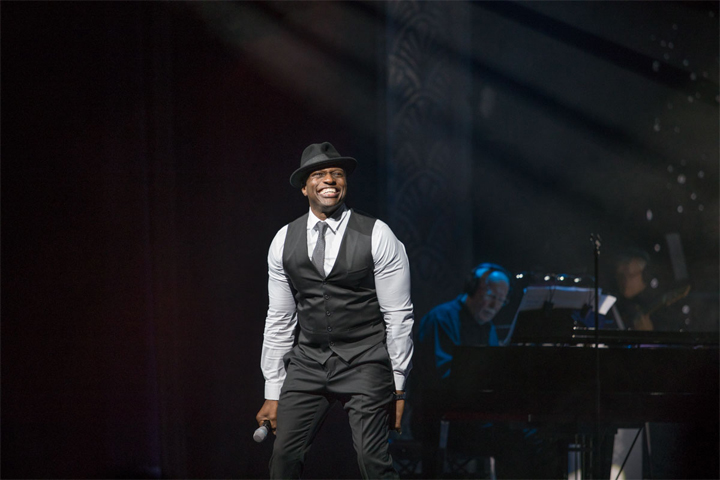
Theater/Show Lounge
- Card Room
- Casino
- Theater/Show Lounge
- Fitness Center
- Pool - Outdoor
- Library
- Wi-Fi
- Business Center
- Concierge Desk
- Dry Cleaning/ Laundry Service
- Elevators
- Safe Deposit Boxes
Activities & Services (available for an extra fee)
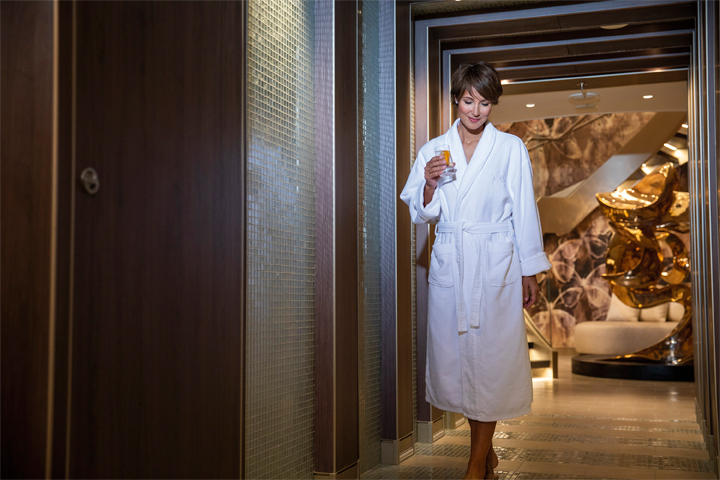
Full-Service Spa
- Full-Service Spa
- Spa Services/Massage
- Duty-Free Shops/Boutiques
- Infirmary/Medical Center
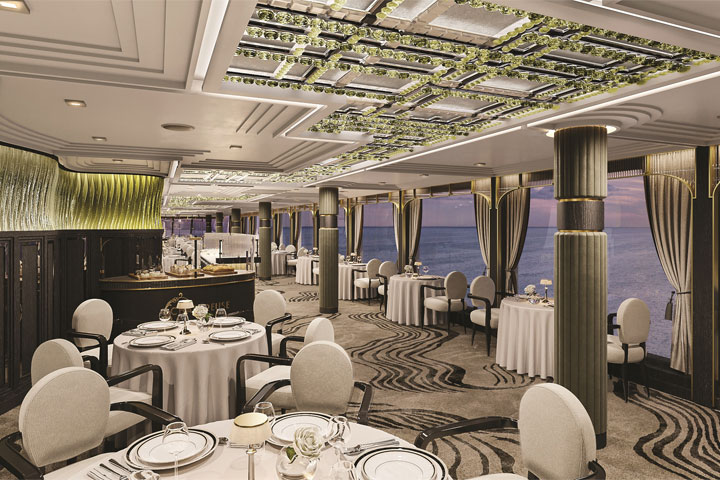
Chartreuse
Specialty Dining
Chartreuse: Featuring a classic French menu with a modern twist, Chartreuse evokes memories of a chic Parisian fine dining restaurant discovered during an evening stroll. Wherever you are seated in this regal restaurant, you will be treated to a succulent dinner while enjoying incredible ocean views. The restaurant ambiance is complemented by a menu that features dishes expertly prepared using both classic and modern techniques for a multiple course celebration of French gastronomy.
Compass Rose: Much thought was given to the design of Compass Rose, the flagship restaurant of Regent Seven Seas fleet. The dining room is outfitted with rich woods contrasted by light marble stones and mother of pearl shimmering brightly with an elegant color theme of light shades of blue, white, gold and silver. Compass Rose delights with a beautifully defined atmosphere and transitions from refreshing natural light during the day to a romantic ice blue lighting theme at night. This is the perfect setting for you to enjoy your breakfast, lunch and dinner, where the menu features an exceptional variety of Continental cuisine.
Pacific Rim: Celebrating the culinary traditions of Asia, Pacific Rim delights guests with the perfect balance of delicious flavors and Zen-like ambiance. The restaurant is located on Deck 5, and the interior glows with muted lighting that illuminates intricate architectural details. During dinner, guests are treated to incredible ocean views through windows designed in an abstract lotus shape, a universal Asian motif. To complement the stunning décor, Pacific Rim's chefs created a delectable menu of Pan-Asian creations with dishes such as grilled Korean barbecue lamb chops, wok-fried beans, eryngii mushroom and gochujang dressing. Pacific Rim is open for dinner each evening, reservations are required.
Prime 7: A true classic in every sense, Prime 7 sets a new standard in steakhouse fare with its contemporary interpretation of an American favorite. Handsomely decorated with supple leather wing-back chairs, burnished woods and rich earth-toned fabrics, Prime 7 exudes a distinct, intimate elegance. All the traditional starters are here, including Jumbo Lump Crab Cakes, Classic Steak Tartare, and Clam Chowder. Of course, beef is the undisputed star, and it is all USDA Prime and Dry-Aged at least 28 days to ensure the ultimate tenderness, juiciness and flavor. Prime New York Strip, Porterhouse Steak and succulent Filet Mignon only touch upon the selections. Mouthwatering alternatives include Alaskan King Crab Legs and Dover Sole. Prime 7 is open for dinner only and reservations are required.
Sette Mari at La Veranda: Each evening, La Veranda transforms into Sette Mari at La Veranda, a casual, intimate dining experience. Enjoy an extensive menu of authentic antipasti and Italian specialties served á la carte and paired with fine Italian wines — complimentary of course. Delectable dishes are prepared á la minute by talented chefs using only the freshest gourmet ingredients and served by attentive waiters. Sette Mari at La Veranda is open for dinner only.
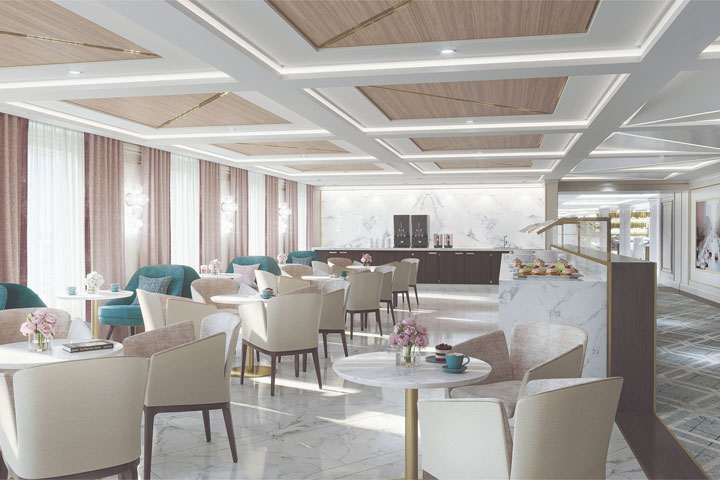
Coffee Connection
Casual Dining
Coffee Connection: Your informal destination to relax, meet fellow guests and enjoy coffee and snacks throughout the day. While snacking, international newspapers and news magazines are available for your perusal.
La Veranda Restaurant: Take in stunning ocean views while enjoying elegant breakfast and lunch buffets in the chic indoor dining room or al fresco on the shaded, open-air deck. Breakfasts include traditional favorites, as well as a made-to-order omelet station, a variety of fresh fruits and pastries, along with daily specials, like fluffy Belgian waffles with fresh blueberry compote. For lunch indulge in an array of choices from a bountiful salad bar, gourmet sandwiches, hot carving stations and delicious desserts.
Pool Grill: The Pool Grill is open-air, yet abundantly shaded for comfortable dining. Enjoy grilled-to-order burgers, grilled seafood, sandwiches, and fresh salads. Treat yourself to milkshakes and malts or an old-fashioned hand-dipped ice cream dessert sprinkled with all your favorite toppings.
Room Service: Complimentary 24-hour dining in the comfort of your stateroom.
Features a European king-size bed, a sitting area, a marble bathroom, a walk-in closet and a balcony. Concierge Level is available.
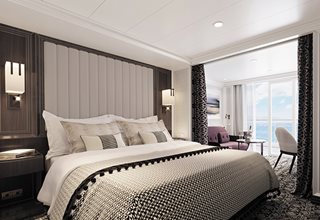
Category: G1
First, the view — soak in the entirety of your ocean-going adventure out on your private balcony, or get cozy in your floor-to-ceiling-windowed sitting area. Inside is perfectly designed for maximum elegance and comfort.
Suite size: 23.5 m²
Balcony size: 8.2 m²
Amenities:- Unlimited Wi-Fi Includes Two Logins, Two Devices, per Suite
- Valet Laundry Service
- Customizable In-Suite Mini Bar Replenished Daily with Your Preferences
- Welcome Bottle of Champagne and Fresh Fruit
- 24-hour In-Suite Dining
- Fresh Orchid Arrangement
- L'Occitane® Jasmin & Bergamot Bath Amenities
- Regent Plush Bathrobe and Slippers
- Interactive Flat-Screen Television and Direct-Dial Satellite Phone
- Vanity and Hair Dryer
- Shoe Shine Service

Category: G2
First, the view — soak in the entirety of your ocean-going adventure out on your private balcony, or get cozy in your floor-to-ceiling-windowed sitting area. Inside is perfectly designed for maximum elegance and comfort.
Suite size: 23.5 m²
Balcony size: 5.1-10.0 m²
Amenities:- Unlimited Wi-Fi Includes Two Logins, Two Devices, per Suite
- Valet Laundry Service
- Customizable In-Suite Mini Bar Replenished Daily with Your Preferences
- Welcome Bottle of Champagne and Fresh Fruit
- 24-hour In-Suite Dining
- Fresh Orchid Arrangement
- L'Occitane® Jasmin & Bergamot Bath Amenities
- Regent Plush Bathrobe and Slippers
- Interactive Flat-Screen Television and Direct-Dial Satellite Phone
- Vanity and Hair Dryer
- Shoe Shine Service

Category: H
A private balcony to sip the beverage of your choice, a sitting area with a table for in-suite breakfasts, lavish bath products, a flat-screen TV... this suite has all you need to feel spoiled on an unforgettable voyage.
Suite size: 20.4 m²
Balcony size: 8.2 m²
Amenities:- Unlimited Wi-Fi Includes Two Logins, Two Devices, per Suite
- Valet Laundry Service
- Customizable In-Suite Mini Bar Replenished Daily with Your Preferences
- Welcome Bottle of Champagne and Fresh Fruit
- 24-hour In-Suite Dining
- Fresh Orchid Arrangement
- L'Occitane® Jasmin & Bergamot Bath Amenities
- Regent Plush Bathrobe and Slippers
- Interactive Flat-Screen Television and Direct-Dial Satellite Phone
- Vanity and Hair Dryer
- Shoe Shine Service
Spacious suites feature an in-suite iPad, daily canapés and upgraded bathroom amenities.
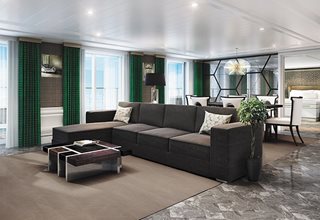
Category: GS
Experience the joy of sailing the world with an exquisitely designed space like this suite to call home throughout your voyage. Indulge in a sumptuous living room, two full baths, lavish bath products, and a private balcony.
The suite pictured may differ from the suite booked, as layouts and designs vary by ship, deck, and suite location.
Suite size: 79.3-94.1 m²
Balcony size: 25.7-85.1 m²
Amenities:- 1-Night Pre-Cruise Hotel Package Including:
- Ground Transfers
- Breakfast
- Porterage
- Unlimited Wi-Fi Includes up to Four Logins, Four Devices, per Suite
- Valet Laundry Service
- 24-hour In-Suite Dining
- Fresh Orchid Arrangement
- L'Occitane® Jasmin & Bergamot Bath Amenities
- Regent Plush Bathrobe and Slippers
- Interactive Flat-Screen Television and Direct-Dial Satellite Phone
- Priority Access to Online Shore Excursion Reservations
- Priority Access to Online Dining Reservations
- Binoculars
- illy® Espresso Maker
- Cashmere Blankets
- Regent Special Gift
- Vanity and Hair Dryer
- Shoe Shine Service
- Additional Discounts:
- 10% Discount on Ultra Premium Wine and Liquor
- 5% Savings on Pre- or Post-Cruise Hotel or Land Programs
- 5% Savings on Regent Choice Shore Excursions
- VIP Status Including Dinner with a Senior Officer
- Guaranteed Reservation Each Night in Specialty Restaurant of Your Choice
- Welcome Letter from the President and General Manager
- Personal Butler for an Elevated In-Suite Experience
- In-Suite Dining Menu Including Specialty Restaurant Selections During Dining Hours
- Priority Boarding on Embarkation Day with Suite Access at Noon
- Welcome Bottle of Premium Champagne
- Personalized In-Suite Full-Liquor Bar Set-Up
- A Sumptuous In-Suite Caviar Service Once During Cruises
- Complimentary In-Suite Cocktail Party for 8
- Complimentary 25-Minute Personal Fitness Session at the Serene Spa & Wellness™ Fitness Center
- Delivery of up to 3 Daily Newspapers and World Atlas
- Daily Canapés
- Tea Forté Set-Up
- Luxe Fruit Arrangement with Chocolate Leonidas
- Luxurious Designer Bath Amenities & Men's Unscented Shaving Kit
- Guerlain Box with Fragrance & Spongellé Buffer
- Dyson Hair Dryer
- Selection of Fig and Tea Leaves Bath Salts
- Guerlain Bath Amenities & Men's Unscented Shaving Kit
- Bath Scale Setup
- Bose® SoundLink Mini II Bluetooth Speaker
- Selection of Bed Pillow Styles
- Complimentary Garment Pressing on First Night
- Personalized Stationery upon request
- Elegant Weather Clock
- Excursion Bag
- 1-Night Pre-Cruise Hotel Package Including:
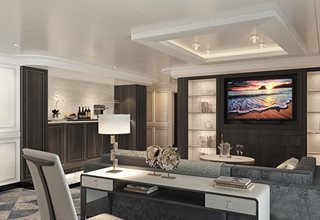
Category: SG
A rich color palette and the finest fabrics create sophisticated comfort and a true urban chic. Plenty of space, including a large living room and a wrap-around private balcony, makes entertaining a breeze.
Suite size: 98.9-103.5 m²
Balcony size: 77.2-92.4 m²
Amenities:- 1-Night Pre-Cruise Hotel Package Including:
- Ground Transfers
- Breakfast
- Porterage
- Unlimited Wi-Fi and Streaming Package for up to Four Devices
- Valet Laundry Service
- 24-hour In-Suite Dining
- Fresh Orchid Arrangement
- L'Occitane® Jasmin & Bergamot Bath Amenities
- Regent Plush Bathrobe and Slippers
- Interactive Flat-Screen Television and Direct-Dial Satellite Phone
- Priority Access to Online Shore Excursion Reservations
- Priority Access to Online Dining Reservations
- Binoculars
- illy® Espresso Maker
- Cashmere Blankets
- Regent Special Gift
- Vanity and Hair Dryer
- Shoe Shine Service
- Additional Discounts:
- 10% Discount on Ultra Premium Wine and Liquor
- 5% Savings on Pre- or Post-Cruise Hotel or Land Programs
- 5% Savings on Regent Choice Shore Excursions
- VIP Status Including Dinner with a Senior Officer
- Guaranteed Reservation Each Night in Specialty Restaurant of Your Choice
- Welcome Letter from the President and General Manager
- Personal Butler for an Elevated In-Suite Experience
- In-Suite Dining Menu Including Specialty Restaurant Selections During Dining Hours
- Priority Boarding on Embarkation Day with Suite Access at Noon
- Welcome Bottle of Premium Champagne
- Personalized In-Suite Full-Liquor Bar Set-Up
- A Sumptuous In-Suite Caviar Service Once During Cruises
- Complimentary In-Suite Cocktail Party for 8
- Complimentary 25-Minute Personal Fitness Session at the Serene Spa & Wellness™ Fitness Center
- Delivery of up to 3 Daily Newspapers and World Atlas
- Daily Canapés
- Tea Forté Set-Up
- Luxe Fruit Arrangement with Chocolate Leonidas
- Luxurious Designer Bath Amenities & Men's Unscented Shaving Kit
- Guerlain Box with Fragrance & Spongellé Buffer
- Dyson Hair Dryer
- Selection of Fig and Tea Leaves Bath Salts
- Guerlain Bath Amenities & Men's Unscented Shaving Kit
- Bath Scale Setup
- Bose® SoundLink Mini II Bluetooth Speaker
- Selection of Bed Pillow Styles
- Complimentary Garment Pressing on First Night
- Personalized Stationery upon request
- Elegant Weather Clock
- Excursion Bag
- 1-Night Pre-Cruise Hotel Package Including:
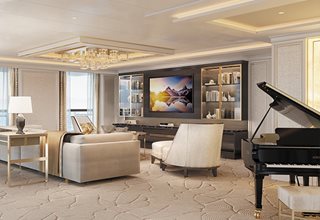
Category: RS
A one-of-a-kind achievement in lavish accommodations, this unparalleled suite boasts an in-suite spa retreat, private balcony with a Treesse Mini Pool, two magnificent bedrooms and more. Simply astonishing luxury.
Suite size: 352.7 m²
Balcony size: 120 m²
Amenities:- 1-Night Pre-Cruise Hotel Package Including:
- Ground Transfers
- Breakfast
- Porterage
- Unlimited Wi-Fi and Streaming Package for up to Four Devices
- Valet Laundry Service
- 24-hour In-Suite Dining
- Fresh Orchid Arrangement
- L'Occitane® Jasmin & Bergamot Bath Amenities
- Regent Plush Bathrobe and Slippers
- Interactive Flat-Screen Television and Direct-Dial Satellite Phone
- Priority Access to Online Shore Excursion Reservations
- Priority Access to Online Dining Reservations
- Binoculars
- illy® Espresso Maker
- Cashmere Blankets
- Regent Special Gift
- Vanity and Hair Dryer
- Shoe Shine Service
- Additional Discounts:
- 10% Discount on Ultra Premium Wine and Liquor
- 5% Savings on Pre- or Post-Cruise Hotel or Land Programs
- 5% Savings on Regent Choice Shore Excursions
- Personal Car and Guide to Explore Ashore
- Daily Serene Spa & Wellness™ Services with Priority Reservations
- Access to The Study, a Private Dining Room for up to 12 Guests
- Unlimited Dry Cleaning
- VIP Status Including Dinner with a Senior Officer
- Guaranteed Reservation Each Night in Specialty Restaurant of Your Choice
- Welcome Letter from the President and General Manager
- Personal Butler for an Elevated In-Suite Experience
- In-Suite Dining Menu Including Specialty Restaurant Selections During Dining Hours
- Priority Boarding on Embarkation Day with Suite Access at Noon
- Welcome Bottle of Dom Pérignon Champagne
- Rémy Martin Louis XIII Cognac 50ml
- Personalized In-Suite Full-Liquor Bar Set-Up
- A Sumptuous In-Suite Caviar Service Once During Cruises
- Complimentary In-Suite Cocktail Party for 8
- Complimentary 25-Minute Personal Fitness Session at the Serene Spa & Wellness™ Fitness Center
- Delivery of up to 3 Daily Newspapers and World Atlas
- Daily Canapés
- Tea Forté Set-Up
- Luxe Fruit Arrangement with Chocolate Leonidas
- Choice of Luxurious Designer Bath Amenities
- Spa Accessories and Spongology Collection
- Guerlain Box with Fragrance & Spongellé Buffer
- Dyson Hair Dryer
- Selection of Fig and Tea Leaves Bath Salts
- Guerlain Bath Amenities & Men's Unscented Shaving Kit
- Bath Scale Setup
- Wallet Make Up Brush Set / Hairbrush and Combo Set
- Bose® SoundLink Mini II Bluetooth Speaker
- Selection of Bed Pillow Styles
- Linen Menu
- Complimentary Garment Pressing on First Night
- Personalized Stationery upon request
- Elegant Weather Clock
- Excursion Bag
- 1-Night Pre-Cruise Hotel Package Including:
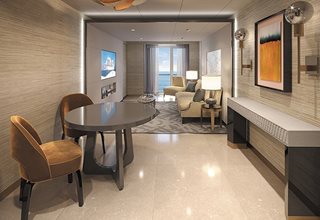
Category: GN
A glamorous home away from home with a private balcony that's among the largest at sea. Luxuriate in its spacious living room and sitting area, and impress guests with a full-liquor bar and in-suite caviar service.
Suite size: 60.9 m²
Balcony size: 15.4-24.4 m²
Amenities:- 1-Night Pre-Cruise Hotel Package Including:
- Ground Transfers
- Breakfast
- Porterage
- Unlimited Wi-Fi Includes up to Four Logins, Four Devices, per Suite
- Valet Laundry Service
- 24-hour In-Suite Dining
- Fresh Orchid Arrangement
- L'Occitane® Jasmin & Bergamot Bath Amenities
- Regent Plush Bathrobe and Slippers
- Interactive Flat-Screen Television and Direct-Dial Satellite Phone
- Priority Access to Online Shore Excursion Reservations
- Priority Access to Online Dining Reservations
- Binoculars
- illy® Espresso Maker
- Cashmere Blankets
- Regent Special Gift
- Vanity and Hair Dryer
- Shoe Shine Service
- Additional Discounts:
- 10% Discount on Ultra Premium Wine and Liquor
- 5% Savings on Pre- or Post-Cruise Hotel or Land Programs
- 5% Savings on Regent Choice Shore Excursions
- Welcome Letter from the President and General Manager
- Personal Butler for an Elevated In-Suite Experience
- In-Suite Dining from Compass Rose
- Priority Boarding on Embarkation Day with Suite Access at 1 pm
- Welcome Bottle of Premium Champagne
- Personalized In-Suite Full-Liquor Bar Set-Up
- A Sumptuous In-Suite Caviar Service Once During Cruises
- Delivery of up to 3 Daily Newspapers and World Atlas
- Daily Canapés
- Luxe Fruit Arrangement
- Luxurious Designer Bath Amenities & Men's Unscented Shaving Kit
- Selection of Fig and Tea Leaves Bath Salts
- Guerlain Bath Amenities & Men's Unscented Shaving Kit
- Bath Scale Setup
- Bose® SoundLink Mini II Bluetooth Speaker
- Selection of Bed Pillow Styles
- Complimentary Garment Pressing on First Night
- Personalized Stationery upon request
- Elegant Weather Clock
- 1-Night Pre-Cruise Hotel Package Including:
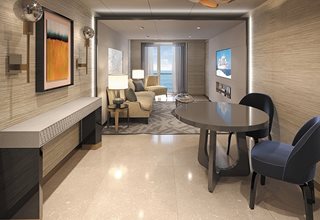
Category: SS
With glorious vistas in every direction, this suite is designed to complement the soothing nature of the world outside. Your private balcony will beckon from your stylish sitting area, as will the marble accents of your baths.
Suite size: 53.6 m²
Balcony size: 22 m²
Amenities:- 1-Night Pre-Cruise Hotel Package Including:
- Ground Transfers
- Breakfast
- Porterage
- Unlimited Wi-Fi Includes up to Four Logins, Four Devices, per Suite
- Valet Laundry Service
- Customizable In-Suite Mini Bar Replenished Daily with Your Preferences
- 24-hour In-Suite Dining
- Fresh Orchid Arrangement
- Luxurious Bath Amenities and Men's Unscented Shaving Kit
- Regent Plush Bathrobe and Slippers
- Interactive Flat-Screen Television and Direct-Dial Satellite Phone
- Priority Access to Online Shore Excursion Reservations
- Priority Access to Online Dining Reservations
- Binoculars
- illy® Espresso Maker
- Cashmere Blankets
- Regent Special Gift
- Vanity and Hair Dryer
- Shoe Shine Service
- Additional Discounts:
- 10% Discount on Ultra Premium Wine and Liquor
- 5% Savings on Pre- or Post-Cruise Hotel or Land Programs
- 5% Savings on Regent Choice Shore Excursions
- Personal Butler for an Elevated In-Suite Experience
- In-Suite Dining from Compass Rose
- Priority Boarding on Embarkation Day with Suite Access at 1 pm
- Daily Canapés
- Luxe Fruit Arrangement
- Luxurious Bath Amenities and Men's Unscented Shaving Kit
- Selection of Fig and Tea Leaves Bath Salts
- Bose® SoundLink Mini II Bluetooth Speaker
- Selection of Bed Pillow Styles
- Complimentary Garment Pressing on First Night
- Personalized Stationery upon request
- Elegant Weather Clock
- 1-Night Pre-Cruise Hotel Package Including:
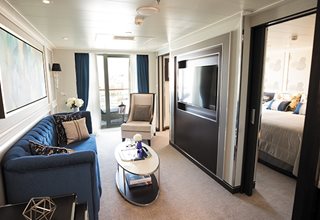
Category: A
Designed to maximize your space and comfort — highlighted by a beautifully furnished sitting area and private balcony — you'll relish time spent in this luxurious suite as you prepare for your next onshore adventure.
Suite size: 41.8 m²
Balcony size: 10.3-16.4 m²
Amenities:- 1-Night Pre-Cruise Hotel Package Including:
- Ground Transfers
- Breakfast
- Porterage
- Unlimited Wi-Fi Includes up to Four Logins, Four Devices, per Suite
- Valet Laundry Service
- Customizable In-Suite Mini Bar Replenished Daily with Your Preferences
- Welcome Bottle of Champagne and Fresh Fruit
- 24-hour In-Suite Dining
- Fresh Orchid Arrangement
- L'Occitane® Jasmin & Bergamot Bath Amenities
- Regent Plush Bathrobe and Slippers
- Interactive Flat-Screen Television and Direct-Dial Satellite Phone
- Priority Access to Online Shore Excursion Reservations
- Priority Access to Online Dining Reservations
- Binoculars
- illy® Espresso Maker
- Cashmere Blankets
- Regent Special Gift
- Vanity and Hair Dryer
- Shoe Shine Service
- Additional Discounts:
- 10% Discount on Ultra Premium Wine and Liquor
- 5% Savings on Pre- or Post-Cruise Hotel or Land Programs
- 5% Savings on Regent Choice Shore Excursions
- Personal Butler for an Elevated In-Suite Experience
- In-Suite Dining from Compass Rose
- Daily Canapés
- Luxurious Designer Bath Amenities & Men's Unscented Shaving Kit
- Guerlain Bath Amenities & Men's Unscented Shaving Kit
- Bose® SoundLink Mini II Bluetooth Speaker
- Selection of Bed Pillow Styles
- Complimentary Garment Pressing on First Night
- Personalized Stationery upon request
- 1-Night Pre-Cruise Hotel Package Including:

Category: B
Designed to maximize your space and comfort — highlighted by a beautifully furnished sitting area and private balcony — you'll relish time spent in this luxurious suite as you prepare for your next onshore adventure.
Suite size: 41.8 m²
Balcony size: 10.3-16.4 m²
Amenities:- 1-Night Pre-Cruise Hotel Package Including:
- Ground Transfers
- Breakfast
- Porterage
- Unlimited Wi-Fi Includes up to Four Logins, Four Devices, per Suite
- Valet Laundry Service
- Customizable In-Suite Mini Bar Replenished Daily with Your Preferences
- Welcome Bottle of Champagne and Fresh Fruit
- 24-hour In-Suite Dining
- Fresh Orchid Arrangement
- L'Occitane® Jasmin & Bergamot Bath Amenities
- Regent Plush Bathrobe and Slippers
- Interactive Flat-Screen Television and Direct-Dial Satellite Phone
- Priority Access to Online Shore Excursion Reservations
- Priority Access to Online Dining Reservations
- Binoculars
- illy® Espresso Maker
- Cashmere Blankets
- Regent Special Gift
- Vanity and Hair Dryer
- Shoe Shine Service
- Additional Discounts:
- 10% Discount on Ultra Premium Wine and Liquor
- 5% Savings on Pre- or Post-Cruise Hotel or Land Programs
- 5% Savings on Regent Choice Shore Excursions
- Personal Butler for an Elevated In-Suite Experience
- In-Suite Dining from Compass Rose
- Daily Canapés
- Luxurious Designer Bath Amenities & Men's Unscented Shaving Kit
- Guerlain Bath Amenities & Men's Unscented Shaving Kit
- Bose® SoundLink Mini II Bluetooth Speaker
- Selection of Bed Pillow Styles
- Complimentary Garment Pressing on First Night
- Personalized Stationery upon request
- 1-Night Pre-Cruise Hotel Package Including:

Category: C
Designed to maximize your space and comfort — highlighted by a beautifully furnished sitting area and private balcony — you'll relish time spent in this luxurious suite as you prepare for your next onshore adventure.
Suite size: 41.8 m²
Balcony size: 10.3-18.0 m²
Amenities:- 1-Night Pre-Cruise Hotel Package Including:
- Ground Transfers
- Breakfast
- Porterage
- Unlimited Wi-Fi Includes up to Four Logins, Four Devices, per Suite
- Valet Laundry Service
- Customizable In-Suite Mini Bar Replenished Daily with Your Preferences
- Welcome Bottle of Champagne and Fresh Fruit
- 24-hour In-Suite Dining
- Fresh Orchid Arrangement
- L'Occitane® Jasmin & Bergamot Bath Amenities
- Regent Plush Bathrobe and Slippers
- Interactive Flat-Screen Television and Direct-Dial Satellite Phone
- Priority Access to Online Shore Excursion Reservations
- Priority Access to Online Dining Reservations
- Binoculars
- illy® Espresso Maker
- Cashmere Blankets
- Regent Special Gift
- Vanity and Hair Dryer
- Shoe Shine Service
- Additional Discounts:
- 10% Discount on Ultra Premium Wine and Liquor
- 5% Savings on Pre- or Post-Cruise Hotel or Land Programs
- 5% Savings on Regent Choice Shore Excursions
- Personal Butler for an Elevated In-Suite Experience
- In-Suite Dining from Compass Rose
- Daily Canapés
- Luxurious Designer Bath Amenities & Men's Unscented Shaving Kit
- Guerlain Bath Amenities & Men's Unscented Shaving Kit
- Bose® SoundLink Mini II Bluetooth Speaker
- Selection of Bed Pillow Styles
- Complimentary Garment Pressing on First Night
- Personalized Stationery upon request
- 1-Night Pre-Cruise Hotel Package Including:
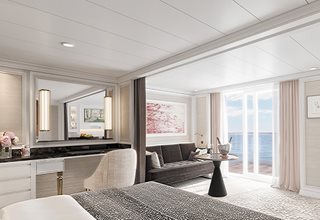
Category: D
Step out onto your private balcony with a freshly made cup of coffee and take in the grandeur of ocean travel. This suite is packed with stylish comfort and includes a king-sized bed with a spectacular horizon view.
Suite size: 30.8 m²
Balcony size: 7.7-12.3 m²
Amenities:- 1-Night Pre-Cruise Hotel Package Including:
- Ground Transfers
- Breakfast
- Porterage
- Unlimited Wi-Fi Includes up to Four Logins, Four Devices, per Suite
- Valet Laundry Service
- Customizable In-Suite Mini Bar Replenished Daily with Your Preferences
- Welcome Bottle of Champagne and Fresh Fruit
- 24-hour In-Suite Dining
- Fresh Orchid Arrangement
- L'Occitane® Jasmin & Bergamot Bath Amenities
- Regent Plush Bathrobe and Slippers
- Interactive Flat-Screen Television and Direct-Dial Satellite Phone
- Priority Access to Online Shore Excursion Reservations
- Priority Access to Online Dining Reservations
- Binoculars
- illy® Espresso Maker
- Cashmere Blankets
- Regent Special Gift
- Vanity and Hair Dryer
- Shoe Shine Service
- Additional Discounts:
- 10% Discount on Ultra Premium Wine and Liquor
- 5% Savings on Pre- or Post-Cruise Hotel or Land Programs
- 5% Savings on Regent Choice Shore Excursions
- 1-Night Pre-Cruise Hotel Package Including:

Category: E
Step out onto your private balcony with a freshly made cup of coffee and take in the grandeur of ocean travel. This suite is packed with stylish comfort and includes a king-sized bed with a spectacular horizon view.
Suite size: 30.8 m²
Balcony size: 10.7-12.3 m²
Amenities:- 1-Night Pre-Cruise Hotel Package Including:
- Ground Transfers
- Breakfast
- Porterage
- Unlimited Wi-Fi Includes up to Four Logins, Four Devices, per Suite
- Valet Laundry Service
- Customizable In-Suite Mini Bar Replenished Daily with Your Preferences
- Welcome Bottle of Champagne and Fresh Fruit
- 24-hour In-Suite Dining
- Fresh Orchid Arrangement
- L'Occitane® Jasmin & Bergamot Bath Amenities
- Regent Plush Bathrobe and Slippers
- Interactive Flat-Screen Television and Direct-Dial Satellite Phone
- Priority Access to Online Shore Excursion Reservations
- Priority Access to Online Dining Reservations
- Binoculars
- illy® Espresso Maker
- Cashmere Blankets
- Regent Special Gift
- Vanity and Hair Dryer
- Shoe Shine Service
- Additional Discounts:
- 10% Discount on Ultra Premium Wine and Liquor
- 5% Savings on Pre- or Post-Cruise Hotel or Land Programs
- 5% Savings on Regent Choice Shore Excursions
- 1-Night Pre-Cruise Hotel Package Including:

Category: F1
Sometimes, a bit of extra space goes a long way. With a stylish living area that includes a sitting area, walk-in closet and dual sinks in the bathroom, you'll have more room to unwind after your daily adventures.
Suite size: 30.8 m²
Balcony size: 7.7-12.3 m²
Amenities:- Unlimited Wi-Fi Includes Two Logins, Two Devices, per Suite
- Valet Laundry Service
- Customizable In-Suite Mini Bar Replenished Daily with Your Preferences
- Welcome Bottle of Champagne and Fresh Fruit
- 24-hour In-Suite Dining
- Fresh Orchid Arrangement
- L'Occitane® Jasmin & Bergamot Bath Amenities
- Regent Plush Bathrobe and Slippers
- Interactive Flat-Screen Television and Direct-Dial Satellite Phone
- Vanity and Hair Dryer
- Shoe Shine Service

Category: F2
A bit of extra space always goes a long way. With a stylish living area that includes a sitting area, walk-in closet and dual sinks in the bathroom, you'll have more room to unwind after your daily adventures.
Suite size: 30.8 m²
Balcony size: 7.7-10.7 m²
Amenities:- Unlimited Wi-Fi Includes Two Logins, Two Devices, per Suite
- Valet Laundry Service
- Customizable In-Suite Mini Bar Replenished Daily with Your Preferences
- Welcome Bottle of Champagne and Fresh Fruit
- 24-hour In-Suite Dining
- Fresh Orchid Arrangement
- L'Occitane® Jasmin & Bergamot Bath Amenities
- Regent Plush Bathrobe and Slippers
- Interactive Flat-Screen Television and Direct-Dial Satellite Phone
- Vanity and Hair Dryer
- Shoe Shine Service
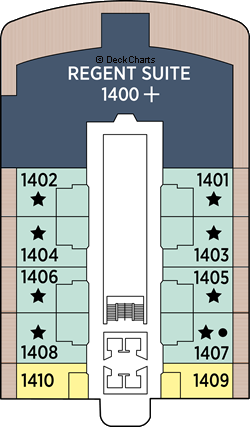
| Symbol | Description |
|---|---|
 | 2-bedroom suites accommodate up to six guests |
 | Convertible sofa bed |
 | Wheelchair accessible suites 822, 823, and 916 have a shower instead of bathtub |
 | Connecting suites |
 | Bathroom features a glass-enclosed shower instead of a bath in categories A, B, C, G1, G2, and H |
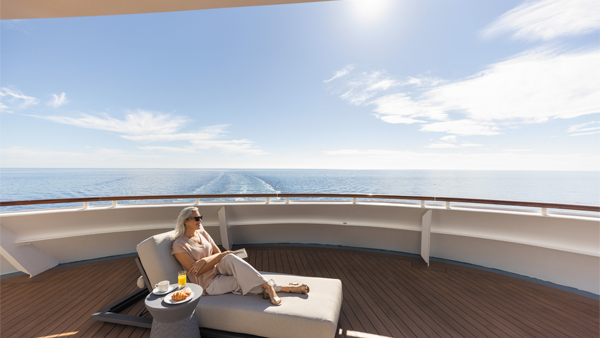
- Ship Name: Seven Seas Grandeur
- Year Built: 2023
- Year Entered Present Fleet: 2023
- Ship Class: Oceanliner
- Maximum Capacity: 750
- Number of Passenger Decks: 10
- Number of Crew: 542
- Officers' Nationality: European
- Tonnage (GRT): 55,498
- Capacity Based on Double Occupancy: 750
- Country of Registry: Marshall Islands
- Total Staterooms: 375
- Suites with Balcony: 375
- Crew/Hotel Staff Nationality: European/International
Costco Member Reviews

Available Dates & Prices
Terms & Conditions
*Price shown is per person based on double occupancy, is valid for select stateroom categories only and does include government taxes/fees and gratuities . Click on Terms & Conditions link below for details.
**Select complimentary shore excursions are for full-fare guests only, capacity controlled and subject to availability. Shore excursion reservations are accepted on a first-come, first-served basis. Please note, available excursions vary by sailing date and day of the week. Government fees and taxes are included. Requested excursions may not be available at time of booking. Supplement will apply on Regent Choice excursions and excludes Private Arrangements and all Adventures Ashore programs. Restrictions apply and penalties apply 36 hours prior to shore excursion start date.
††All shipboard credit is in U.S. dollars, is per stateroom based on double occupancy, has no cash value, is nontransferable and not redeemable for cash.
†One Digital Costco Shop Card per room/stateroom, per stay. The exact amount of the Digital Costco Shop Card will be calculated during the booking process. The Digital Costco Shop Card promotion is nontransferable and may not be combined with any other promotion. A Digital Costco Shop Card will arrive by email approximately 10 days after the start of your cruise. Click on the Terms & Conditions link below for additional information.
Ship's registry: The Marshall Islands
Digital Costco Shop Card
Book this vacation or cruise with Costco Travel and receive a Digital Costco Shop Card. The Digital Costco Shop Card is a convenient payment option in our warehouses and on Costco.ca.















